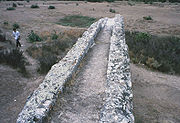
Opus signinum
Encyclopedia

Ancient Rome
Ancient Rome was a thriving civilization that grew on the Italian Peninsula as early as the 8th century BC. Located along the Mediterranean Sea and centered on the city of Rome, it expanded to one of the largest empires in the ancient world....
. It is made of tiles broken up into very small pieces, mixed with mortar, and then beaten down with a rammer. Pliny in his Natural History describes its manufacture: "Even broken pottery has been utilized; it being found that, beaten to powder, and tempered with lime, it becomes more solid and durable than other substances of a similar nature; forming the cement known as the "Signine" composition, so extensively employed for even making the pavements of houses."
Origins, spread, disuse
The technique began in North Africa, some time before 256 B.C., and spread north from there to Sicily and finally to the Italian peninsula. Floors of signinum are found extensively in the Punic towns of North Africa and commonly in the Hellenistic houses on Sicily. While some signinum pavements have been found in Rome, the technique is not common there. VitruviusVitruvius
Marcus Vitruvius Pollio was a Roman writer, architect and engineer, active in the 1st century BC. He is best known as the author of the multi-volume work De Architectura ....
describes the process of laying a floor, whether signinum or mosaic. The trend began in the 1st century BC, proliferating in private homes as well as public buildings. By the 2nd century, opus signinum would give way to more patterned styles of pavement.

